NUR332: Assimilation Policy Impact on Aboriginal Young People Report
VerifiedAdded on 2022/11/02
|13
|3617
|445
Report
AI Summary
This report examines the profound and lasting impact of the 1961 Assimilation Policy on the health and well-being of Australian Indigenous young people. It begins by outlining the pre-invasion health status of Aboriginal populations, highlighting the high mortality rates and prevalence of infectious diseases. The report then contrasts this with the current health status, acknowledging improvements while emphasizing persistent disparities in healthcare access and outcomes. A central focus is the critical analysis of the intent and implementation of the Assimilation Policy, detailing its detrimental effects on Aboriginal families, cultural identity, and overall health. The report explores specific issues such as smoking during pregnancy, traditional birth practices, and the challenges faced in education and professional employment. It underscores the importance of cultural safety and collaborative approaches in healthcare to address historical injustices and reduce health inequalities. The report concludes by emphasizing the need for healthcare professionals to understand the historical context and work in partnership with Aboriginal communities to foster culturally safe healthcare services and promote positive change.
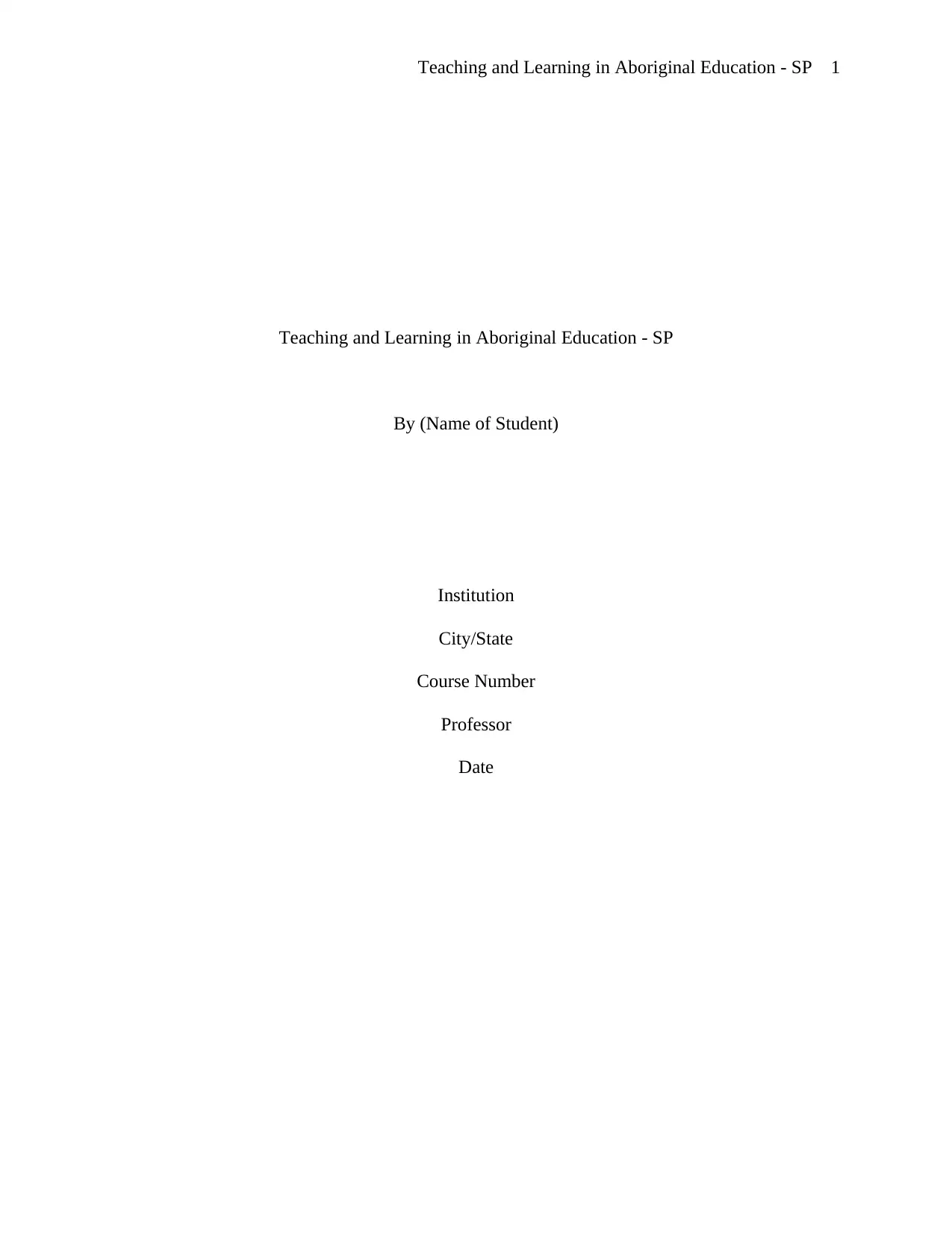
Teaching and Learning in Aboriginal Education - SP 1
Teaching and Learning in Aboriginal Education - SP
By (Name of Student)
Institution
City/State
Course Number
Professor
Date
Teaching and Learning in Aboriginal Education - SP
By (Name of Student)
Institution
City/State
Course Number
Professor
Date
Paraphrase This Document
Need a fresh take? Get an instant paraphrase of this document with our AI Paraphraser
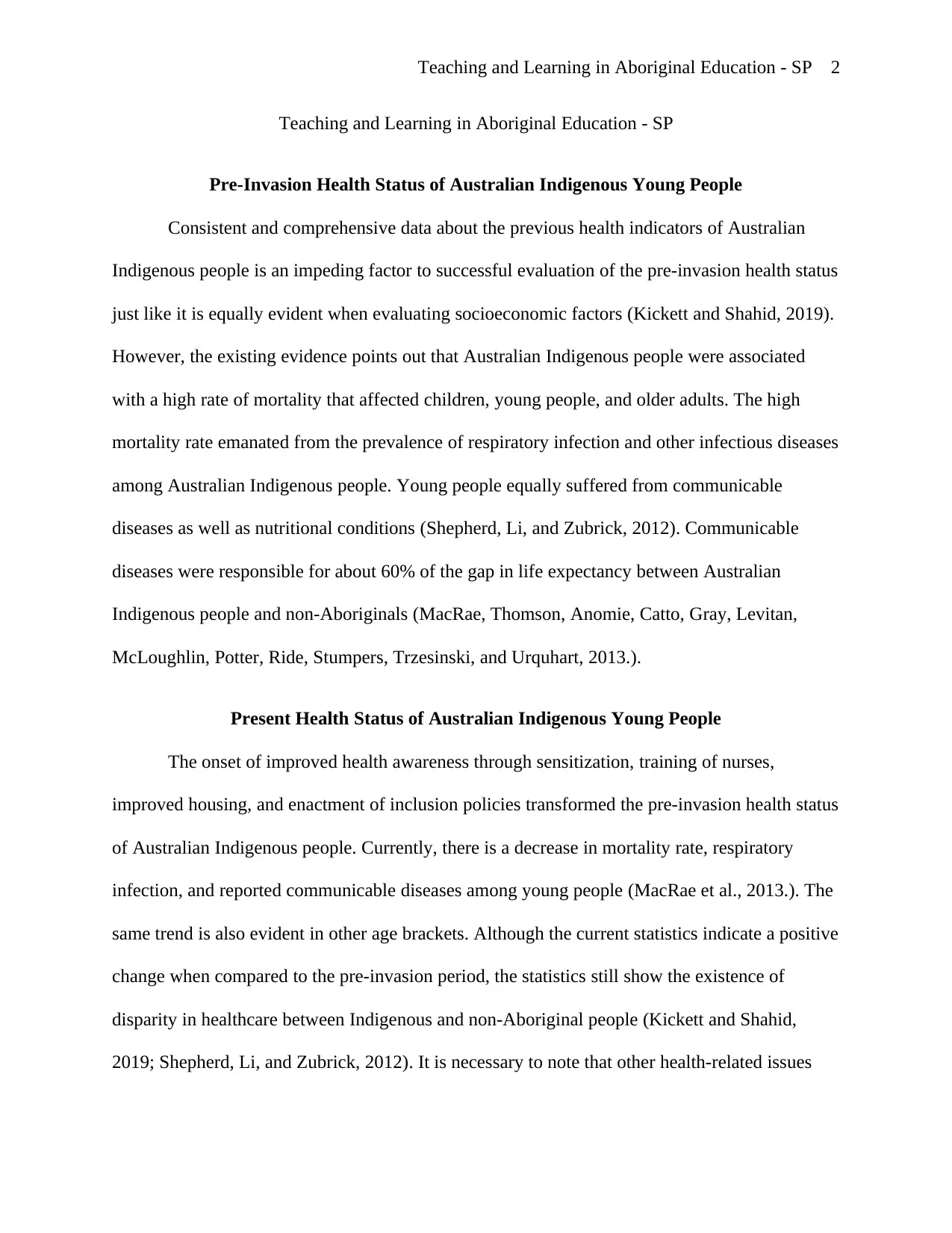
Teaching and Learning in Aboriginal Education - SP 2
Teaching and Learning in Aboriginal Education - SP
Pre-Invasion Health Status of Australian Indigenous Young People
Consistent and comprehensive data about the previous health indicators of Australian
Indigenous people is an impeding factor to successful evaluation of the pre-invasion health status
just like it is equally evident when evaluating socioeconomic factors (Kickett and Shahid, 2019).
However, the existing evidence points out that Australian Indigenous people were associated
with a high rate of mortality that affected children, young people, and older adults. The high
mortality rate emanated from the prevalence of respiratory infection and other infectious diseases
among Australian Indigenous people. Young people equally suffered from communicable
diseases as well as nutritional conditions (Shepherd, Li, and Zubrick, 2012). Communicable
diseases were responsible for about 60% of the gap in life expectancy between Australian
Indigenous people and non-Aboriginals (MacRae, Thomson, Anomie, Catto, Gray, Levitan,
McLoughlin, Potter, Ride, Stumpers, Trzesinski, and Urquhart, 2013.).
Present Health Status of Australian Indigenous Young People
The onset of improved health awareness through sensitization, training of nurses,
improved housing, and enactment of inclusion policies transformed the pre-invasion health status
of Australian Indigenous people. Currently, there is a decrease in mortality rate, respiratory
infection, and reported communicable diseases among young people (MacRae et al., 2013.). The
same trend is also evident in other age brackets. Although the current statistics indicate a positive
change when compared to the pre-invasion period, the statistics still show the existence of
disparity in healthcare between Indigenous and non-Aboriginal people (Kickett and Shahid,
2019; Shepherd, Li, and Zubrick, 2012). It is necessary to note that other health-related issues
Teaching and Learning in Aboriginal Education - SP
Pre-Invasion Health Status of Australian Indigenous Young People
Consistent and comprehensive data about the previous health indicators of Australian
Indigenous people is an impeding factor to successful evaluation of the pre-invasion health status
just like it is equally evident when evaluating socioeconomic factors (Kickett and Shahid, 2019).
However, the existing evidence points out that Australian Indigenous people were associated
with a high rate of mortality that affected children, young people, and older adults. The high
mortality rate emanated from the prevalence of respiratory infection and other infectious diseases
among Australian Indigenous people. Young people equally suffered from communicable
diseases as well as nutritional conditions (Shepherd, Li, and Zubrick, 2012). Communicable
diseases were responsible for about 60% of the gap in life expectancy between Australian
Indigenous people and non-Aboriginals (MacRae, Thomson, Anomie, Catto, Gray, Levitan,
McLoughlin, Potter, Ride, Stumpers, Trzesinski, and Urquhart, 2013.).
Present Health Status of Australian Indigenous Young People
The onset of improved health awareness through sensitization, training of nurses,
improved housing, and enactment of inclusion policies transformed the pre-invasion health status
of Australian Indigenous people. Currently, there is a decrease in mortality rate, respiratory
infection, and reported communicable diseases among young people (MacRae et al., 2013.). The
same trend is also evident in other age brackets. Although the current statistics indicate a positive
change when compared to the pre-invasion period, the statistics still show the existence of
disparity in healthcare between Indigenous and non-Aboriginal people (Kickett and Shahid,
2019; Shepherd, Li, and Zubrick, 2012). It is necessary to note that other health-related issues
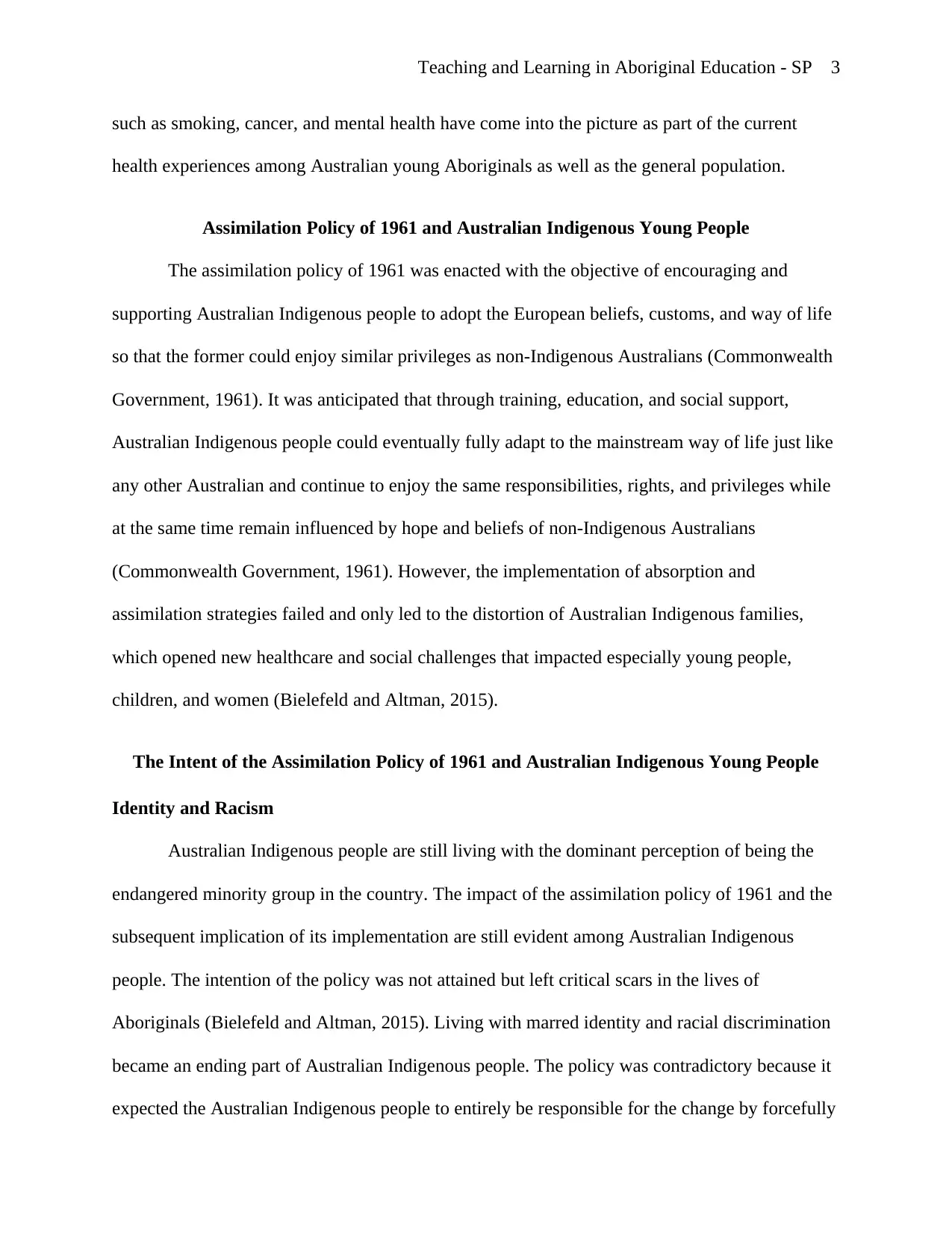
Teaching and Learning in Aboriginal Education - SP 3
such as smoking, cancer, and mental health have come into the picture as part of the current
health experiences among Australian young Aboriginals as well as the general population.
Assimilation Policy of 1961 and Australian Indigenous Young People
The assimilation policy of 1961 was enacted with the objective of encouraging and
supporting Australian Indigenous people to adopt the European beliefs, customs, and way of life
so that the former could enjoy similar privileges as non-Indigenous Australians (Commonwealth
Government, 1961). It was anticipated that through training, education, and social support,
Australian Indigenous people could eventually fully adapt to the mainstream way of life just like
any other Australian and continue to enjoy the same responsibilities, rights, and privileges while
at the same time remain influenced by hope and beliefs of non-Indigenous Australians
(Commonwealth Government, 1961). However, the implementation of absorption and
assimilation strategies failed and only led to the distortion of Australian Indigenous families,
which opened new healthcare and social challenges that impacted especially young people,
children, and women (Bielefeld and Altman, 2015).
The Intent of the Assimilation Policy of 1961 and Australian Indigenous Young People
Identity and Racism
Australian Indigenous people are still living with the dominant perception of being the
endangered minority group in the country. The impact of the assimilation policy of 1961 and the
subsequent implication of its implementation are still evident among Australian Indigenous
people. The intention of the policy was not attained but left critical scars in the lives of
Aboriginals (Bielefeld and Altman, 2015). Living with marred identity and racial discrimination
became an ending part of Australian Indigenous people. The policy was contradictory because it
expected the Australian Indigenous people to entirely be responsible for the change by forcefully
such as smoking, cancer, and mental health have come into the picture as part of the current
health experiences among Australian young Aboriginals as well as the general population.
Assimilation Policy of 1961 and Australian Indigenous Young People
The assimilation policy of 1961 was enacted with the objective of encouraging and
supporting Australian Indigenous people to adopt the European beliefs, customs, and way of life
so that the former could enjoy similar privileges as non-Indigenous Australians (Commonwealth
Government, 1961). It was anticipated that through training, education, and social support,
Australian Indigenous people could eventually fully adapt to the mainstream way of life just like
any other Australian and continue to enjoy the same responsibilities, rights, and privileges while
at the same time remain influenced by hope and beliefs of non-Indigenous Australians
(Commonwealth Government, 1961). However, the implementation of absorption and
assimilation strategies failed and only led to the distortion of Australian Indigenous families,
which opened new healthcare and social challenges that impacted especially young people,
children, and women (Bielefeld and Altman, 2015).
The Intent of the Assimilation Policy of 1961 and Australian Indigenous Young People
Identity and Racism
Australian Indigenous people are still living with the dominant perception of being the
endangered minority group in the country. The impact of the assimilation policy of 1961 and the
subsequent implication of its implementation are still evident among Australian Indigenous
people. The intention of the policy was not attained but left critical scars in the lives of
Aboriginals (Bielefeld and Altman, 2015). Living with marred identity and racial discrimination
became an ending part of Australian Indigenous people. The policy was contradictory because it
expected the Australian Indigenous people to entirely be responsible for the change by forcefully
⊘ This is a preview!⊘
Do you want full access?
Subscribe today to unlock all pages.

Trusted by 1+ million students worldwide
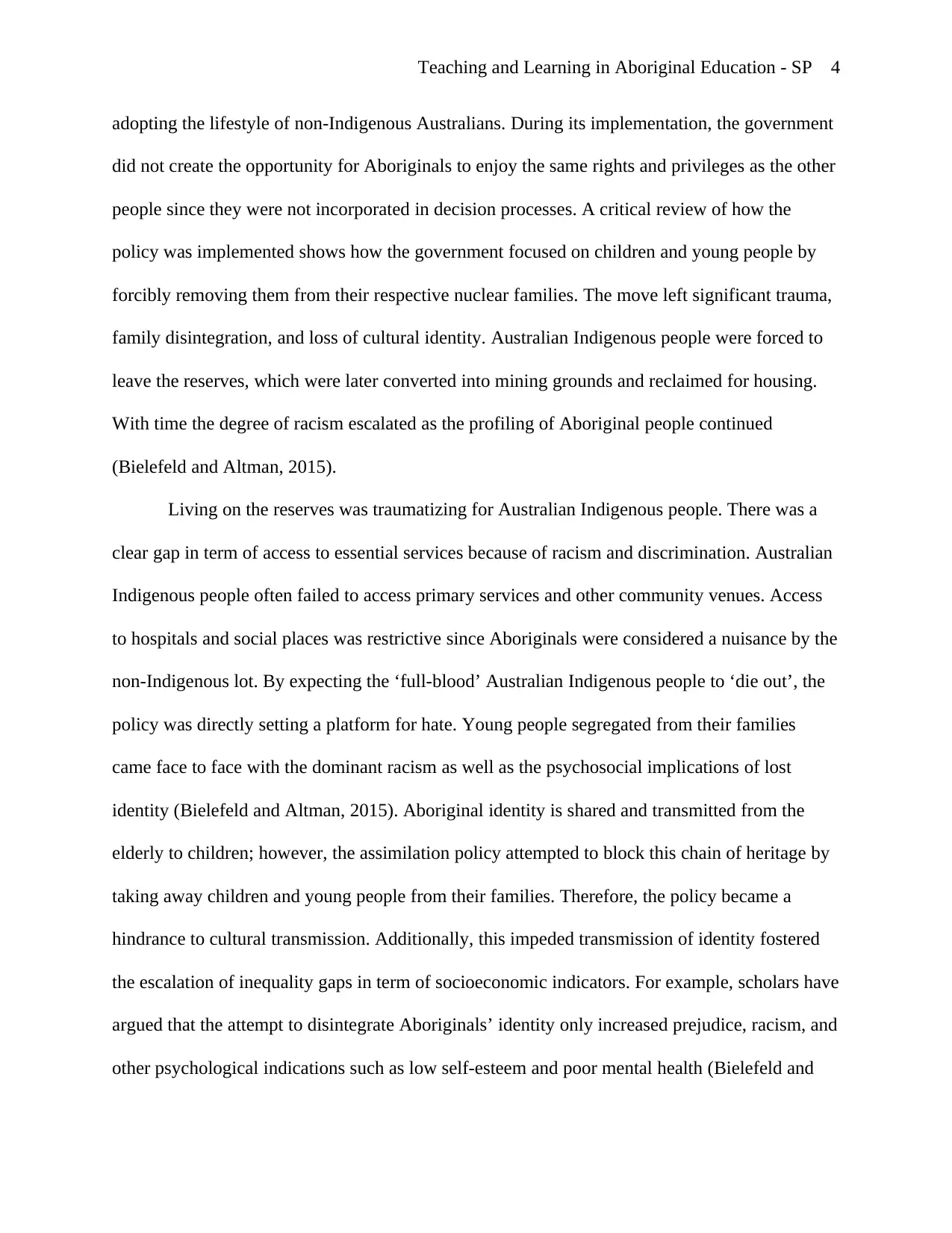
Teaching and Learning in Aboriginal Education - SP 4
adopting the lifestyle of non-Indigenous Australians. During its implementation, the government
did not create the opportunity for Aboriginals to enjoy the same rights and privileges as the other
people since they were not incorporated in decision processes. A critical review of how the
policy was implemented shows how the government focused on children and young people by
forcibly removing them from their respective nuclear families. The move left significant trauma,
family disintegration, and loss of cultural identity. Australian Indigenous people were forced to
leave the reserves, which were later converted into mining grounds and reclaimed for housing.
With time the degree of racism escalated as the profiling of Aboriginal people continued
(Bielefeld and Altman, 2015).
Living on the reserves was traumatizing for Australian Indigenous people. There was a
clear gap in term of access to essential services because of racism and discrimination. Australian
Indigenous people often failed to access primary services and other community venues. Access
to hospitals and social places was restrictive since Aboriginals were considered a nuisance by the
non-Indigenous lot. By expecting the ‘full-blood’ Australian Indigenous people to ‘die out’, the
policy was directly setting a platform for hate. Young people segregated from their families
came face to face with the dominant racism as well as the psychosocial implications of lost
identity (Bielefeld and Altman, 2015). Aboriginal identity is shared and transmitted from the
elderly to children; however, the assimilation policy attempted to block this chain of heritage by
taking away children and young people from their families. Therefore, the policy became a
hindrance to cultural transmission. Additionally, this impeded transmission of identity fostered
the escalation of inequality gaps in term of socioeconomic indicators. For example, scholars have
argued that the attempt to disintegrate Aboriginals’ identity only increased prejudice, racism, and
other psychological indications such as low self-esteem and poor mental health (Bielefeld and
adopting the lifestyle of non-Indigenous Australians. During its implementation, the government
did not create the opportunity for Aboriginals to enjoy the same rights and privileges as the other
people since they were not incorporated in decision processes. A critical review of how the
policy was implemented shows how the government focused on children and young people by
forcibly removing them from their respective nuclear families. The move left significant trauma,
family disintegration, and loss of cultural identity. Australian Indigenous people were forced to
leave the reserves, which were later converted into mining grounds and reclaimed for housing.
With time the degree of racism escalated as the profiling of Aboriginal people continued
(Bielefeld and Altman, 2015).
Living on the reserves was traumatizing for Australian Indigenous people. There was a
clear gap in term of access to essential services because of racism and discrimination. Australian
Indigenous people often failed to access primary services and other community venues. Access
to hospitals and social places was restrictive since Aboriginals were considered a nuisance by the
non-Indigenous lot. By expecting the ‘full-blood’ Australian Indigenous people to ‘die out’, the
policy was directly setting a platform for hate. Young people segregated from their families
came face to face with the dominant racism as well as the psychosocial implications of lost
identity (Bielefeld and Altman, 2015). Aboriginal identity is shared and transmitted from the
elderly to children; however, the assimilation policy attempted to block this chain of heritage by
taking away children and young people from their families. Therefore, the policy became a
hindrance to cultural transmission. Additionally, this impeded transmission of identity fostered
the escalation of inequality gaps in term of socioeconomic indicators. For example, scholars have
argued that the attempt to disintegrate Aboriginals’ identity only increased prejudice, racism, and
other psychological indications such as low self-esteem and poor mental health (Bielefeld and
Paraphrase This Document
Need a fresh take? Get an instant paraphrase of this document with our AI Paraphraser
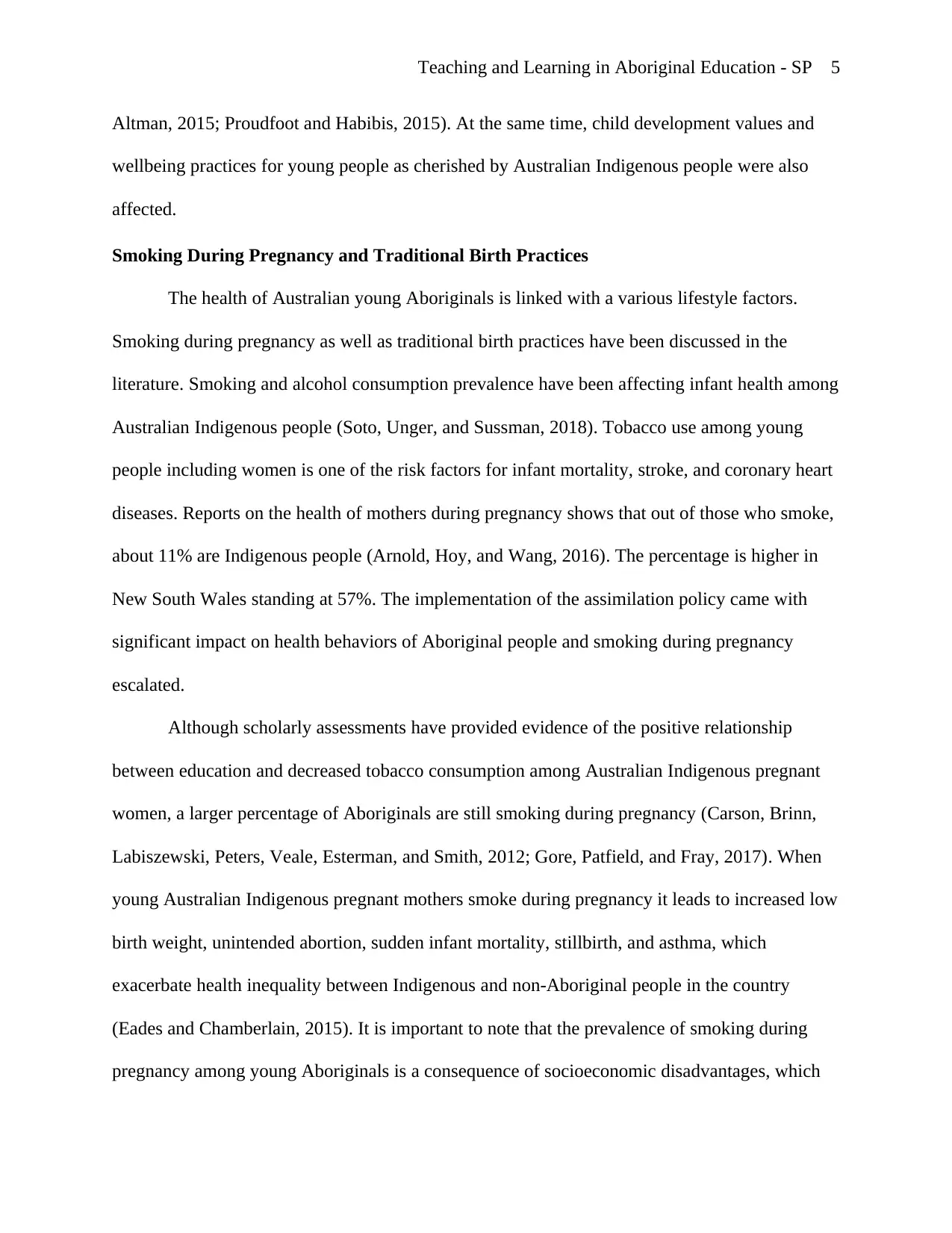
Teaching and Learning in Aboriginal Education - SP 5
Altman, 2015; Proudfoot and Habibis, 2015). At the same time, child development values and
wellbeing practices for young people as cherished by Australian Indigenous people were also
affected.
Smoking During Pregnancy and Traditional Birth Practices
The health of Australian young Aboriginals is linked with a various lifestyle factors.
Smoking during pregnancy as well as traditional birth practices have been discussed in the
literature. Smoking and alcohol consumption prevalence have been affecting infant health among
Australian Indigenous people (Soto, Unger, and Sussman, 2018). Tobacco use among young
people including women is one of the risk factors for infant mortality, stroke, and coronary heart
diseases. Reports on the health of mothers during pregnancy shows that out of those who smoke,
about 11% are Indigenous people (Arnold, Hoy, and Wang, 2016). The percentage is higher in
New South Wales standing at 57%. The implementation of the assimilation policy came with
significant impact on health behaviors of Aboriginal people and smoking during pregnancy
escalated.
Although scholarly assessments have provided evidence of the positive relationship
between education and decreased tobacco consumption among Australian Indigenous pregnant
women, a larger percentage of Aboriginals are still smoking during pregnancy (Carson, Brinn,
Labiszewski, Peters, Veale, Esterman, and Smith, 2012; Gore, Patfield, and Fray, 2017). When
young Australian Indigenous pregnant mothers smoke during pregnancy it leads to increased low
birth weight, unintended abortion, sudden infant mortality, stillbirth, and asthma, which
exacerbate health inequality between Indigenous and non-Aboriginal people in the country
(Eades and Chamberlain, 2015). It is important to note that the prevalence of smoking during
pregnancy among young Aboriginals is a consequence of socioeconomic disadvantages, which
Altman, 2015; Proudfoot and Habibis, 2015). At the same time, child development values and
wellbeing practices for young people as cherished by Australian Indigenous people were also
affected.
Smoking During Pregnancy and Traditional Birth Practices
The health of Australian young Aboriginals is linked with a various lifestyle factors.
Smoking during pregnancy as well as traditional birth practices have been discussed in the
literature. Smoking and alcohol consumption prevalence have been affecting infant health among
Australian Indigenous people (Soto, Unger, and Sussman, 2018). Tobacco use among young
people including women is one of the risk factors for infant mortality, stroke, and coronary heart
diseases. Reports on the health of mothers during pregnancy shows that out of those who smoke,
about 11% are Indigenous people (Arnold, Hoy, and Wang, 2016). The percentage is higher in
New South Wales standing at 57%. The implementation of the assimilation policy came with
significant impact on health behaviors of Aboriginal people and smoking during pregnancy
escalated.
Although scholarly assessments have provided evidence of the positive relationship
between education and decreased tobacco consumption among Australian Indigenous pregnant
women, a larger percentage of Aboriginals are still smoking during pregnancy (Carson, Brinn,
Labiszewski, Peters, Veale, Esterman, and Smith, 2012; Gore, Patfield, and Fray, 2017). When
young Australian Indigenous pregnant mothers smoke during pregnancy it leads to increased low
birth weight, unintended abortion, sudden infant mortality, stillbirth, and asthma, which
exacerbate health inequality between Indigenous and non-Aboriginal people in the country
(Eades and Chamberlain, 2015). It is important to note that the prevalence of smoking during
pregnancy among young Aboriginals is a consequence of socioeconomic disadvantages, which
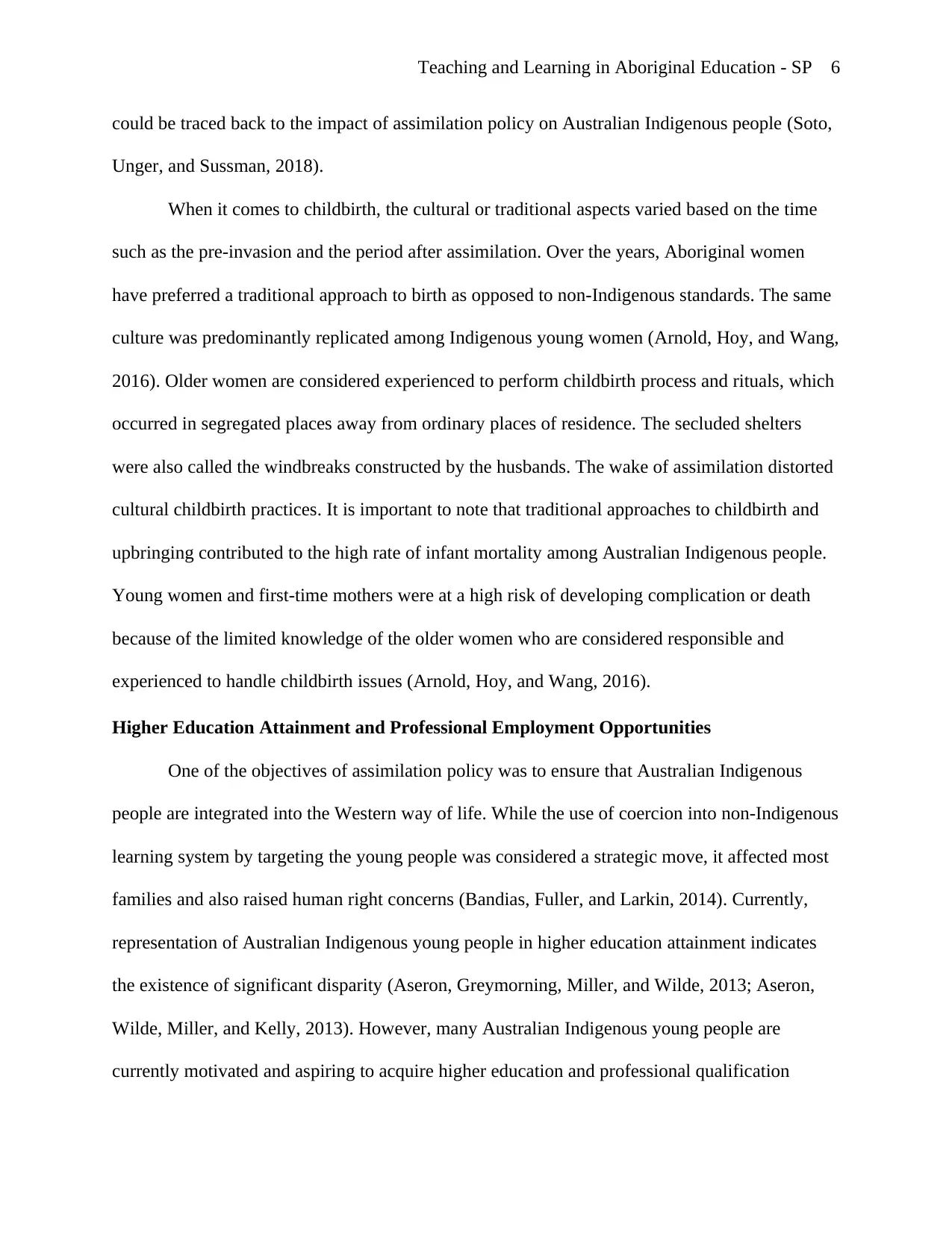
Teaching and Learning in Aboriginal Education - SP 6
could be traced back to the impact of assimilation policy on Australian Indigenous people (Soto,
Unger, and Sussman, 2018).
When it comes to childbirth, the cultural or traditional aspects varied based on the time
such as the pre-invasion and the period after assimilation. Over the years, Aboriginal women
have preferred a traditional approach to birth as opposed to non-Indigenous standards. The same
culture was predominantly replicated among Indigenous young women (Arnold, Hoy, and Wang,
2016). Older women are considered experienced to perform childbirth process and rituals, which
occurred in segregated places away from ordinary places of residence. The secluded shelters
were also called the windbreaks constructed by the husbands. The wake of assimilation distorted
cultural childbirth practices. It is important to note that traditional approaches to childbirth and
upbringing contributed to the high rate of infant mortality among Australian Indigenous people.
Young women and first-time mothers were at a high risk of developing complication or death
because of the limited knowledge of the older women who are considered responsible and
experienced to handle childbirth issues (Arnold, Hoy, and Wang, 2016).
Higher Education Attainment and Professional Employment Opportunities
One of the objectives of assimilation policy was to ensure that Australian Indigenous
people are integrated into the Western way of life. While the use of coercion into non-Indigenous
learning system by targeting the young people was considered a strategic move, it affected most
families and also raised human right concerns (Bandias, Fuller, and Larkin, 2014). Currently,
representation of Australian Indigenous young people in higher education attainment indicates
the existence of significant disparity (Aseron, Greymorning, Miller, and Wilde, 2013; Aseron,
Wilde, Miller, and Kelly, 2013). However, many Australian Indigenous young people are
currently motivated and aspiring to acquire higher education and professional qualification
could be traced back to the impact of assimilation policy on Australian Indigenous people (Soto,
Unger, and Sussman, 2018).
When it comes to childbirth, the cultural or traditional aspects varied based on the time
such as the pre-invasion and the period after assimilation. Over the years, Aboriginal women
have preferred a traditional approach to birth as opposed to non-Indigenous standards. The same
culture was predominantly replicated among Indigenous young women (Arnold, Hoy, and Wang,
2016). Older women are considered experienced to perform childbirth process and rituals, which
occurred in segregated places away from ordinary places of residence. The secluded shelters
were also called the windbreaks constructed by the husbands. The wake of assimilation distorted
cultural childbirth practices. It is important to note that traditional approaches to childbirth and
upbringing contributed to the high rate of infant mortality among Australian Indigenous people.
Young women and first-time mothers were at a high risk of developing complication or death
because of the limited knowledge of the older women who are considered responsible and
experienced to handle childbirth issues (Arnold, Hoy, and Wang, 2016).
Higher Education Attainment and Professional Employment Opportunities
One of the objectives of assimilation policy was to ensure that Australian Indigenous
people are integrated into the Western way of life. While the use of coercion into non-Indigenous
learning system by targeting the young people was considered a strategic move, it affected most
families and also raised human right concerns (Bandias, Fuller, and Larkin, 2014). Currently,
representation of Australian Indigenous young people in higher education attainment indicates
the existence of significant disparity (Aseron, Greymorning, Miller, and Wilde, 2013; Aseron,
Wilde, Miller, and Kelly, 2013). However, many Australian Indigenous young people are
currently motivated and aspiring to acquire higher education and professional qualification
⊘ This is a preview!⊘
Do you want full access?
Subscribe today to unlock all pages.

Trusted by 1+ million students worldwide
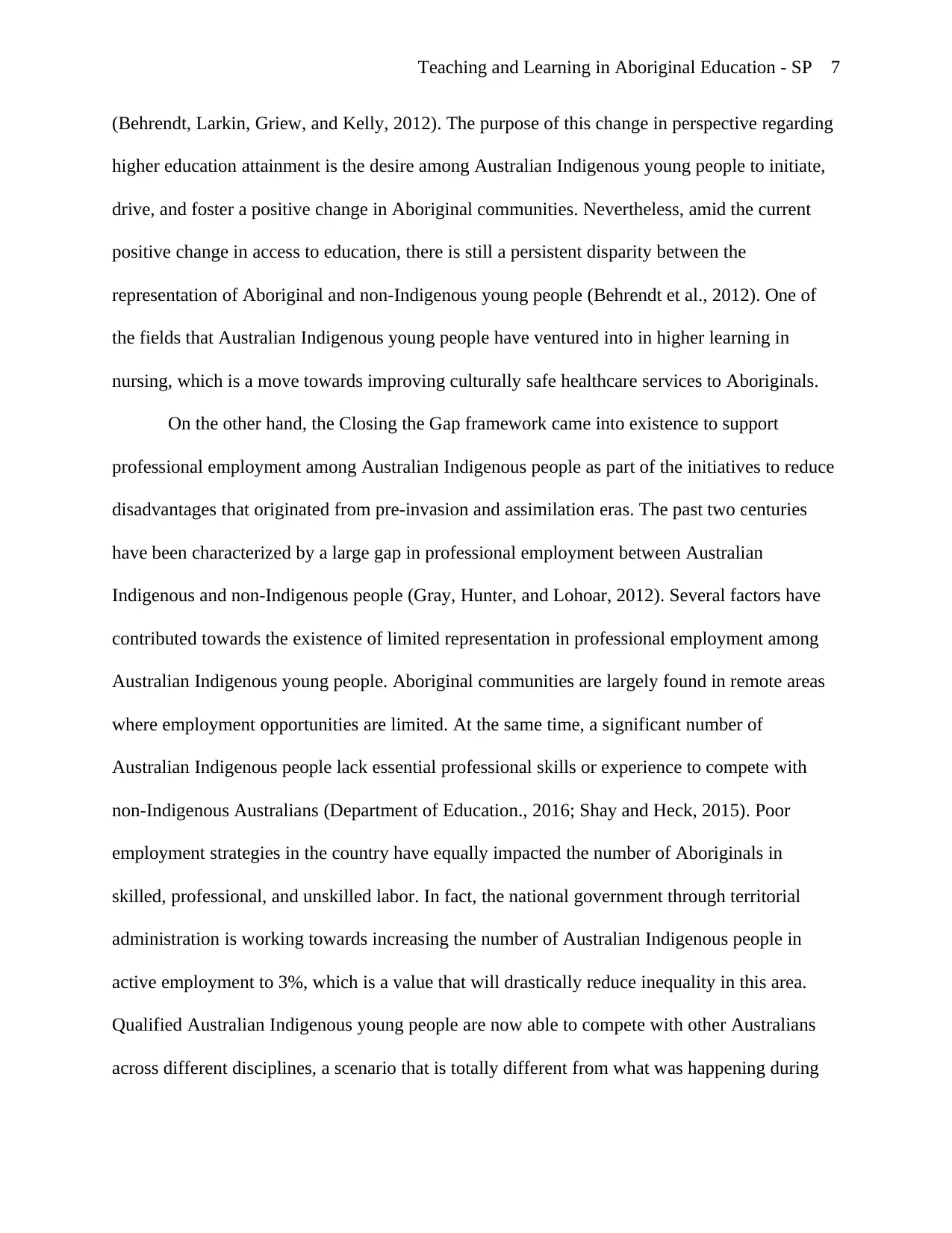
Teaching and Learning in Aboriginal Education - SP 7
(Behrendt, Larkin, Griew, and Kelly, 2012). The purpose of this change in perspective regarding
higher education attainment is the desire among Australian Indigenous young people to initiate,
drive, and foster a positive change in Aboriginal communities. Nevertheless, amid the current
positive change in access to education, there is still a persistent disparity between the
representation of Aboriginal and non-Indigenous young people (Behrendt et al., 2012). One of
the fields that Australian Indigenous young people have ventured into in higher learning in
nursing, which is a move towards improving culturally safe healthcare services to Aboriginals.
On the other hand, the Closing the Gap framework came into existence to support
professional employment among Australian Indigenous people as part of the initiatives to reduce
disadvantages that originated from pre-invasion and assimilation eras. The past two centuries
have been characterized by a large gap in professional employment between Australian
Indigenous and non-Indigenous people (Gray, Hunter, and Lohoar, 2012). Several factors have
contributed towards the existence of limited representation in professional employment among
Australian Indigenous young people. Aboriginal communities are largely found in remote areas
where employment opportunities are limited. At the same time, a significant number of
Australian Indigenous people lack essential professional skills or experience to compete with
non-Indigenous Australians (Department of Education., 2016; Shay and Heck, 2015). Poor
employment strategies in the country have equally impacted the number of Aboriginals in
skilled, professional, and unskilled labor. In fact, the national government through territorial
administration is working towards increasing the number of Australian Indigenous people in
active employment to 3%, which is a value that will drastically reduce inequality in this area.
Qualified Australian Indigenous young people are now able to compete with other Australians
across different disciplines, a scenario that is totally different from what was happening during
(Behrendt, Larkin, Griew, and Kelly, 2012). The purpose of this change in perspective regarding
higher education attainment is the desire among Australian Indigenous young people to initiate,
drive, and foster a positive change in Aboriginal communities. Nevertheless, amid the current
positive change in access to education, there is still a persistent disparity between the
representation of Aboriginal and non-Indigenous young people (Behrendt et al., 2012). One of
the fields that Australian Indigenous young people have ventured into in higher learning in
nursing, which is a move towards improving culturally safe healthcare services to Aboriginals.
On the other hand, the Closing the Gap framework came into existence to support
professional employment among Australian Indigenous people as part of the initiatives to reduce
disadvantages that originated from pre-invasion and assimilation eras. The past two centuries
have been characterized by a large gap in professional employment between Australian
Indigenous and non-Indigenous people (Gray, Hunter, and Lohoar, 2012). Several factors have
contributed towards the existence of limited representation in professional employment among
Australian Indigenous young people. Aboriginal communities are largely found in remote areas
where employment opportunities are limited. At the same time, a significant number of
Australian Indigenous people lack essential professional skills or experience to compete with
non-Indigenous Australians (Department of Education., 2016; Shay and Heck, 2015). Poor
employment strategies in the country have equally impacted the number of Aboriginals in
skilled, professional, and unskilled labor. In fact, the national government through territorial
administration is working towards increasing the number of Australian Indigenous people in
active employment to 3%, which is a value that will drastically reduce inequality in this area.
Qualified Australian Indigenous young people are now able to compete with other Australians
across different disciplines, a scenario that is totally different from what was happening during
Paraphrase This Document
Need a fresh take? Get an instant paraphrase of this document with our AI Paraphraser
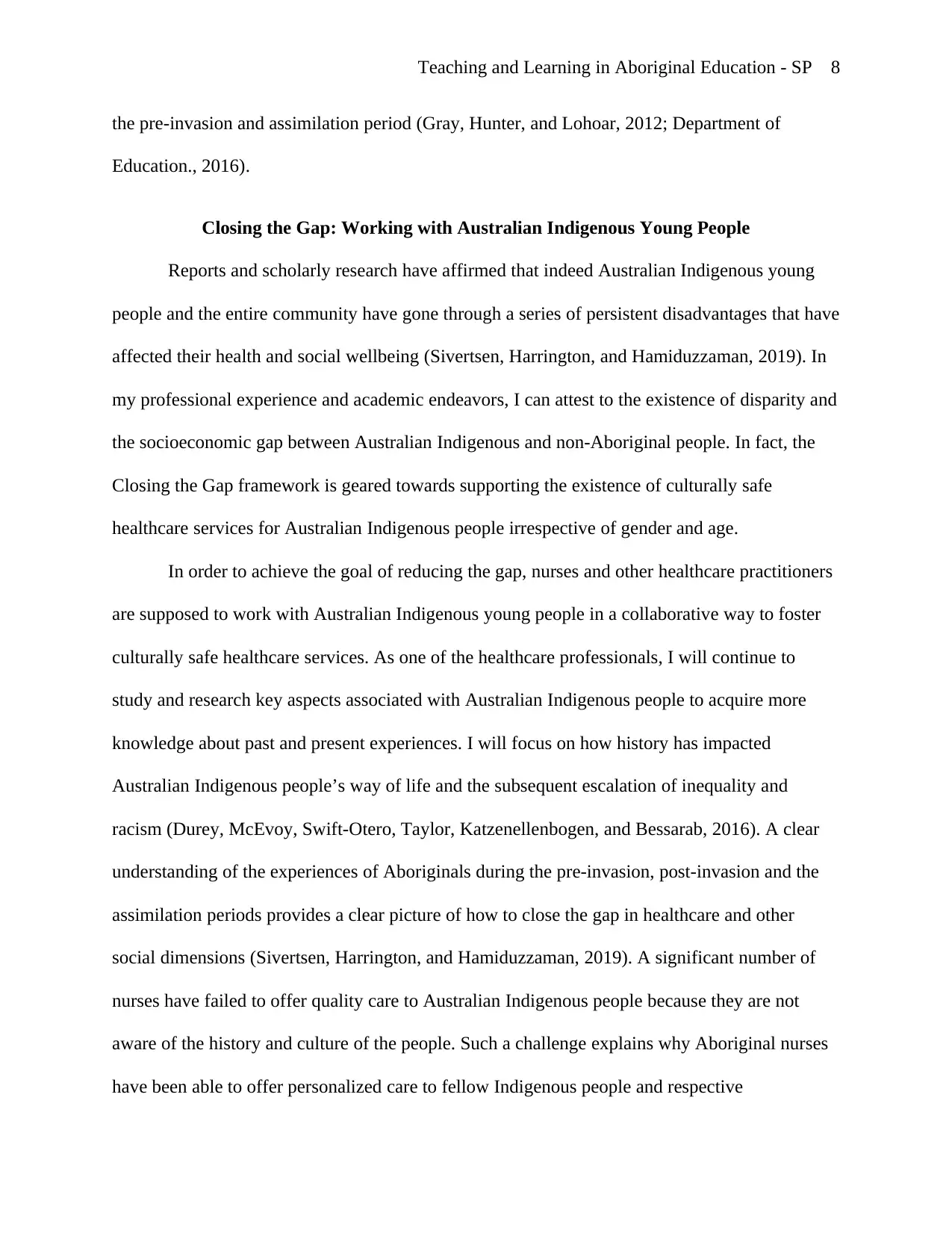
Teaching and Learning in Aboriginal Education - SP 8
the pre-invasion and assimilation period (Gray, Hunter, and Lohoar, 2012; Department of
Education., 2016).
Closing the Gap: Working with Australian Indigenous Young People
Reports and scholarly research have affirmed that indeed Australian Indigenous young
people and the entire community have gone through a series of persistent disadvantages that have
affected their health and social wellbeing (Sivertsen, Harrington, and Hamiduzzaman, 2019). In
my professional experience and academic endeavors, I can attest to the existence of disparity and
the socioeconomic gap between Australian Indigenous and non-Aboriginal people. In fact, the
Closing the Gap framework is geared towards supporting the existence of culturally safe
healthcare services for Australian Indigenous people irrespective of gender and age.
In order to achieve the goal of reducing the gap, nurses and other healthcare practitioners
are supposed to work with Australian Indigenous young people in a collaborative way to foster
culturally safe healthcare services. As one of the healthcare professionals, I will continue to
study and research key aspects associated with Australian Indigenous people to acquire more
knowledge about past and present experiences. I will focus on how history has impacted
Australian Indigenous people’s way of life and the subsequent escalation of inequality and
racism (Durey, McEvoy, Swift-Otero, Taylor, Katzenellenbogen, and Bessarab, 2016). A clear
understanding of the experiences of Aboriginals during the pre-invasion, post-invasion and the
assimilation periods provides a clear picture of how to close the gap in healthcare and other
social dimensions (Sivertsen, Harrington, and Hamiduzzaman, 2019). A significant number of
nurses have failed to offer quality care to Australian Indigenous people because they are not
aware of the history and culture of the people. Such a challenge explains why Aboriginal nurses
have been able to offer personalized care to fellow Indigenous people and respective
the pre-invasion and assimilation period (Gray, Hunter, and Lohoar, 2012; Department of
Education., 2016).
Closing the Gap: Working with Australian Indigenous Young People
Reports and scholarly research have affirmed that indeed Australian Indigenous young
people and the entire community have gone through a series of persistent disadvantages that have
affected their health and social wellbeing (Sivertsen, Harrington, and Hamiduzzaman, 2019). In
my professional experience and academic endeavors, I can attest to the existence of disparity and
the socioeconomic gap between Australian Indigenous and non-Aboriginal people. In fact, the
Closing the Gap framework is geared towards supporting the existence of culturally safe
healthcare services for Australian Indigenous people irrespective of gender and age.
In order to achieve the goal of reducing the gap, nurses and other healthcare practitioners
are supposed to work with Australian Indigenous young people in a collaborative way to foster
culturally safe healthcare services. As one of the healthcare professionals, I will continue to
study and research key aspects associated with Australian Indigenous people to acquire more
knowledge about past and present experiences. I will focus on how history has impacted
Australian Indigenous people’s way of life and the subsequent escalation of inequality and
racism (Durey, McEvoy, Swift-Otero, Taylor, Katzenellenbogen, and Bessarab, 2016). A clear
understanding of the experiences of Aboriginals during the pre-invasion, post-invasion and the
assimilation periods provides a clear picture of how to close the gap in healthcare and other
social dimensions (Sivertsen, Harrington, and Hamiduzzaman, 2019). A significant number of
nurses have failed to offer quality care to Australian Indigenous people because they are not
aware of the history and culture of the people. Such a challenge explains why Aboriginal nurses
have been able to offer personalized care to fellow Indigenous people and respective
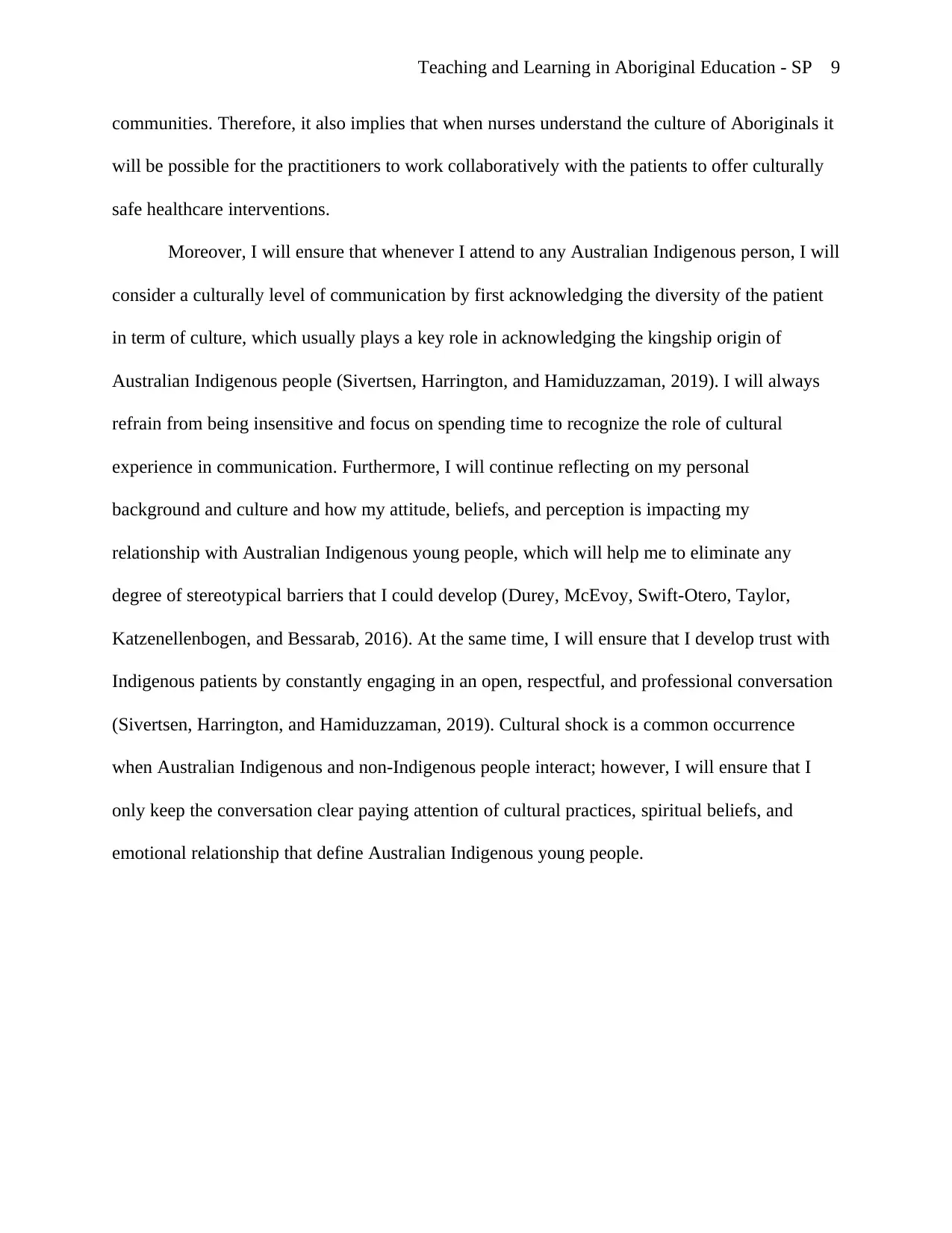
Teaching and Learning in Aboriginal Education - SP 9
communities. Therefore, it also implies that when nurses understand the culture of Aboriginals it
will be possible for the practitioners to work collaboratively with the patients to offer culturally
safe healthcare interventions.
Moreover, I will ensure that whenever I attend to any Australian Indigenous person, I will
consider a culturally level of communication by first acknowledging the diversity of the patient
in term of culture, which usually plays a key role in acknowledging the kingship origin of
Australian Indigenous people (Sivertsen, Harrington, and Hamiduzzaman, 2019). I will always
refrain from being insensitive and focus on spending time to recognize the role of cultural
experience in communication. Furthermore, I will continue reflecting on my personal
background and culture and how my attitude, beliefs, and perception is impacting my
relationship with Australian Indigenous young people, which will help me to eliminate any
degree of stereotypical barriers that I could develop (Durey, McEvoy, Swift-Otero, Taylor,
Katzenellenbogen, and Bessarab, 2016). At the same time, I will ensure that I develop trust with
Indigenous patients by constantly engaging in an open, respectful, and professional conversation
(Sivertsen, Harrington, and Hamiduzzaman, 2019). Cultural shock is a common occurrence
when Australian Indigenous and non-Indigenous people interact; however, I will ensure that I
only keep the conversation clear paying attention of cultural practices, spiritual beliefs, and
emotional relationship that define Australian Indigenous young people.
communities. Therefore, it also implies that when nurses understand the culture of Aboriginals it
will be possible for the practitioners to work collaboratively with the patients to offer culturally
safe healthcare interventions.
Moreover, I will ensure that whenever I attend to any Australian Indigenous person, I will
consider a culturally level of communication by first acknowledging the diversity of the patient
in term of culture, which usually plays a key role in acknowledging the kingship origin of
Australian Indigenous people (Sivertsen, Harrington, and Hamiduzzaman, 2019). I will always
refrain from being insensitive and focus on spending time to recognize the role of cultural
experience in communication. Furthermore, I will continue reflecting on my personal
background and culture and how my attitude, beliefs, and perception is impacting my
relationship with Australian Indigenous young people, which will help me to eliminate any
degree of stereotypical barriers that I could develop (Durey, McEvoy, Swift-Otero, Taylor,
Katzenellenbogen, and Bessarab, 2016). At the same time, I will ensure that I develop trust with
Indigenous patients by constantly engaging in an open, respectful, and professional conversation
(Sivertsen, Harrington, and Hamiduzzaman, 2019). Cultural shock is a common occurrence
when Australian Indigenous and non-Indigenous people interact; however, I will ensure that I
only keep the conversation clear paying attention of cultural practices, spiritual beliefs, and
emotional relationship that define Australian Indigenous young people.
⊘ This is a preview!⊘
Do you want full access?
Subscribe today to unlock all pages.

Trusted by 1+ million students worldwide
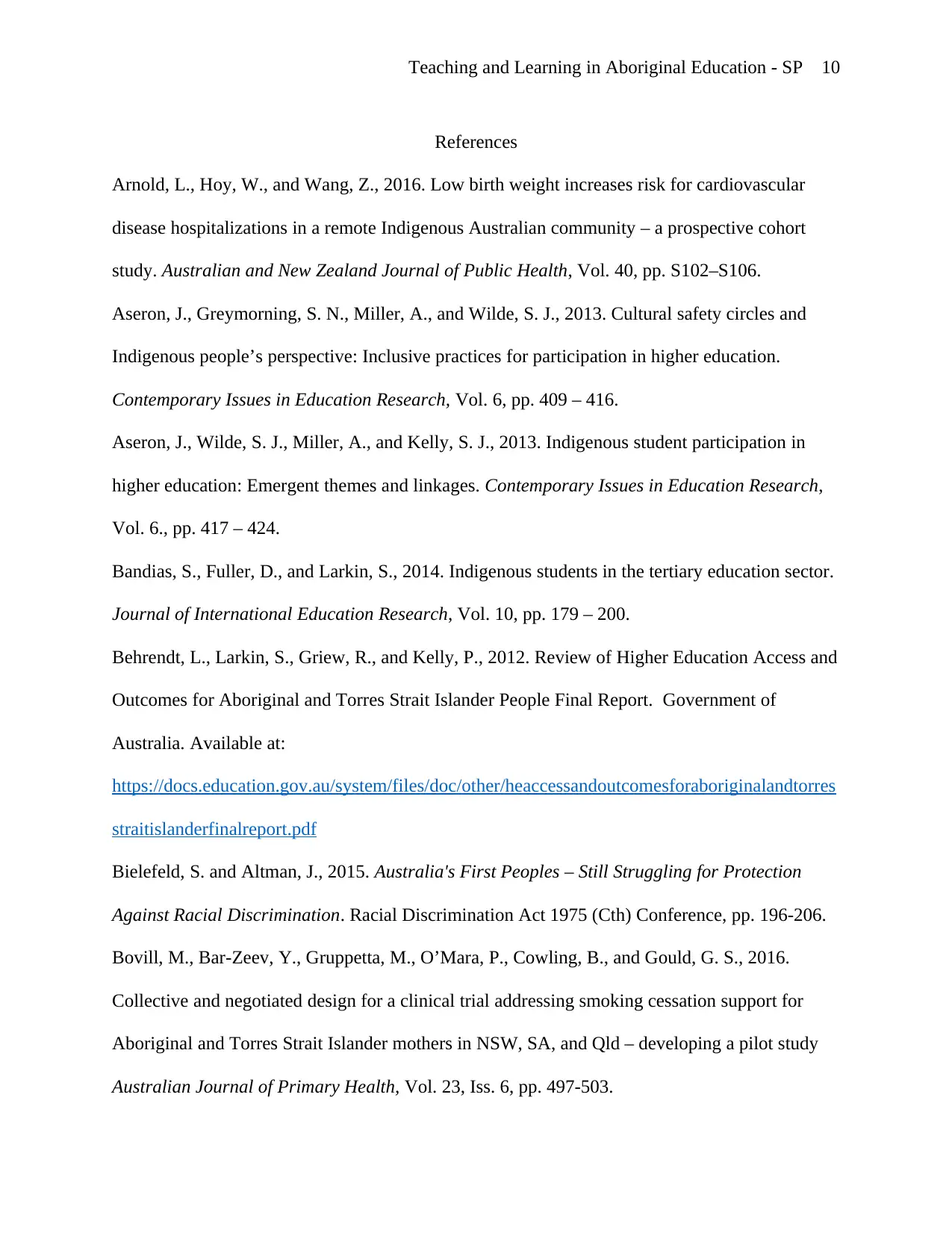
Teaching and Learning in Aboriginal Education - SP 10
References
Arnold, L., Hoy, W., and Wang, Z., 2016. Low birth weight increases risk for cardiovascular
disease hospitalizations in a remote Indigenous Australian community – a prospective cohort
study. Australian and New Zealand Journal of Public Health, Vol. 40, pp. S102–S106.
Aseron, J., Greymorning, S. N., Miller, A., and Wilde, S. J., 2013. Cultural safety circles and
Indigenous people’s perspective: Inclusive practices for participation in higher education.
Contemporary Issues in Education Research, Vol. 6, pp. 409 – 416.
Aseron, J., Wilde, S. J., Miller, A., and Kelly, S. J., 2013. Indigenous student participation in
higher education: Emergent themes and linkages. Contemporary Issues in Education Research,
Vol. 6., pp. 417 – 424.
Bandias, S., Fuller, D., and Larkin, S., 2014. Indigenous students in the tertiary education sector.
Journal of International Education Research, Vol. 10, pp. 179 – 200.
Behrendt, L., Larkin, S., Griew, R., and Kelly, P., 2012. Review of Higher Education Access and
Outcomes for Aboriginal and Torres Strait Islander People Final Report. Government of
Australia. Available at:
https://docs.education.gov.au/system/files/doc/other/heaccessandoutcomesforaboriginalandtorres
straitislanderfinalreport.pdf
Bielefeld, S. and Altman, J., 2015. Australia's First Peoples – Still Struggling for Protection
Against Racial Discrimination. Racial Discrimination Act 1975 (Cth) Conference, pp. 196-206.
Bovill, M., Bar-Zeev, Y., Gruppetta, M., O’Mara, P., Cowling, B., and Gould, G. S., 2016.
Collective and negotiated design for a clinical trial addressing smoking cessation support for
Aboriginal and Torres Strait Islander mothers in NSW, SA, and Qld – developing a pilot study
Australian Journal of Primary Health, Vol. 23, Iss. 6, pp. 497-503.
References
Arnold, L., Hoy, W., and Wang, Z., 2016. Low birth weight increases risk for cardiovascular
disease hospitalizations in a remote Indigenous Australian community – a prospective cohort
study. Australian and New Zealand Journal of Public Health, Vol. 40, pp. S102–S106.
Aseron, J., Greymorning, S. N., Miller, A., and Wilde, S. J., 2013. Cultural safety circles and
Indigenous people’s perspective: Inclusive practices for participation in higher education.
Contemporary Issues in Education Research, Vol. 6, pp. 409 – 416.
Aseron, J., Wilde, S. J., Miller, A., and Kelly, S. J., 2013. Indigenous student participation in
higher education: Emergent themes and linkages. Contemporary Issues in Education Research,
Vol. 6., pp. 417 – 424.
Bandias, S., Fuller, D., and Larkin, S., 2014. Indigenous students in the tertiary education sector.
Journal of International Education Research, Vol. 10, pp. 179 – 200.
Behrendt, L., Larkin, S., Griew, R., and Kelly, P., 2012. Review of Higher Education Access and
Outcomes for Aboriginal and Torres Strait Islander People Final Report. Government of
Australia. Available at:
https://docs.education.gov.au/system/files/doc/other/heaccessandoutcomesforaboriginalandtorres
straitislanderfinalreport.pdf
Bielefeld, S. and Altman, J., 2015. Australia's First Peoples – Still Struggling for Protection
Against Racial Discrimination. Racial Discrimination Act 1975 (Cth) Conference, pp. 196-206.
Bovill, M., Bar-Zeev, Y., Gruppetta, M., O’Mara, P., Cowling, B., and Gould, G. S., 2016.
Collective and negotiated design for a clinical trial addressing smoking cessation support for
Aboriginal and Torres Strait Islander mothers in NSW, SA, and Qld – developing a pilot study
Australian Journal of Primary Health, Vol. 23, Iss. 6, pp. 497-503.
Paraphrase This Document
Need a fresh take? Get an instant paraphrase of this document with our AI Paraphraser
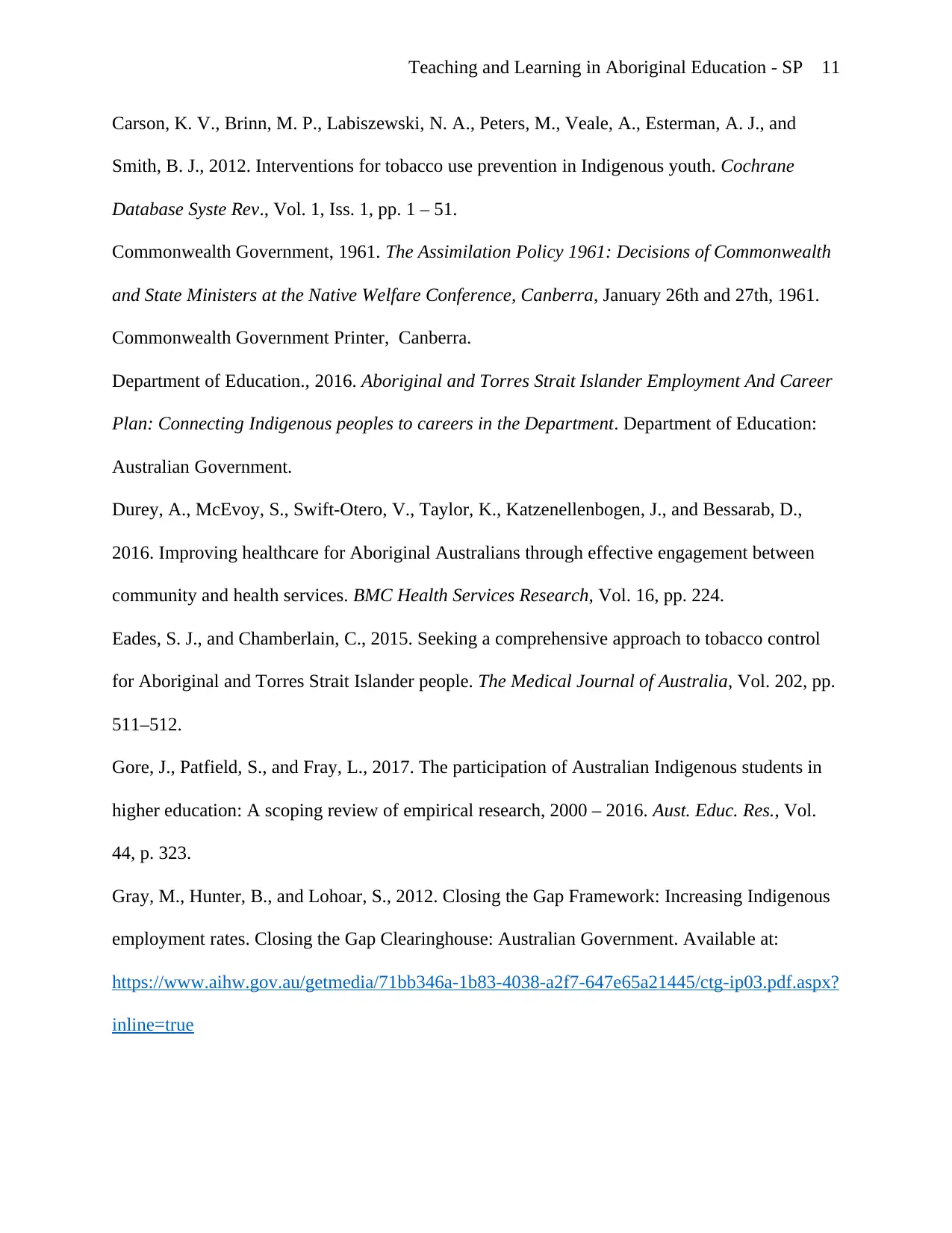
Teaching and Learning in Aboriginal Education - SP 11
Carson, K. V., Brinn, M. P., Labiszewski, N. A., Peters, M., Veale, A., Esterman, A. J., and
Smith, B. J., 2012. Interventions for tobacco use prevention in Indigenous youth. Cochrane
Database Syste Rev., Vol. 1, Iss. 1, pp. 1 – 51.
Commonwealth Government, 1961. The Assimilation Policy 1961: Decisions of Commonwealth
and State Ministers at the Native Welfare Conference, Canberra, January 26th and 27th, 1961.
Commonwealth Government Printer, Canberra.
Department of Education., 2016. Aboriginal and Torres Strait Islander Employment And Career
Plan: Connecting Indigenous peoples to careers in the Department. Department of Education:
Australian Government.
Durey, A., McEvoy, S., Swift-Otero, V., Taylor, K., Katzenellenbogen, J., and Bessarab, D.,
2016. Improving healthcare for Aboriginal Australians through effective engagement between
community and health services. BMC Health Services Research, Vol. 16, pp. 224.
Eades, S. J., and Chamberlain, C., 2015. Seeking a comprehensive approach to tobacco control
for Aboriginal and Torres Strait Islander people. The Medical Journal of Australia, Vol. 202, pp.
511–512.
Gore, J., Patfield, S., and Fray, L., 2017. The participation of Australian Indigenous students in
higher education: A scoping review of empirical research, 2000 – 2016. Aust. Educ. Res., Vol.
44, p. 323.
Gray, M., Hunter, B., and Lohoar, S., 2012. Closing the Gap Framework: Increasing Indigenous
employment rates. Closing the Gap Clearinghouse: Australian Government. Available at:
https://www.aihw.gov.au/getmedia/71bb346a-1b83-4038-a2f7-647e65a21445/ctg-ip03.pdf.aspx?
inline=true
Carson, K. V., Brinn, M. P., Labiszewski, N. A., Peters, M., Veale, A., Esterman, A. J., and
Smith, B. J., 2012. Interventions for tobacco use prevention in Indigenous youth. Cochrane
Database Syste Rev., Vol. 1, Iss. 1, pp. 1 – 51.
Commonwealth Government, 1961. The Assimilation Policy 1961: Decisions of Commonwealth
and State Ministers at the Native Welfare Conference, Canberra, January 26th and 27th, 1961.
Commonwealth Government Printer, Canberra.
Department of Education., 2016. Aboriginal and Torres Strait Islander Employment And Career
Plan: Connecting Indigenous peoples to careers in the Department. Department of Education:
Australian Government.
Durey, A., McEvoy, S., Swift-Otero, V., Taylor, K., Katzenellenbogen, J., and Bessarab, D.,
2016. Improving healthcare for Aboriginal Australians through effective engagement between
community and health services. BMC Health Services Research, Vol. 16, pp. 224.
Eades, S. J., and Chamberlain, C., 2015. Seeking a comprehensive approach to tobacco control
for Aboriginal and Torres Strait Islander people. The Medical Journal of Australia, Vol. 202, pp.
511–512.
Gore, J., Patfield, S., and Fray, L., 2017. The participation of Australian Indigenous students in
higher education: A scoping review of empirical research, 2000 – 2016. Aust. Educ. Res., Vol.
44, p. 323.
Gray, M., Hunter, B., and Lohoar, S., 2012. Closing the Gap Framework: Increasing Indigenous
employment rates. Closing the Gap Clearinghouse: Australian Government. Available at:
https://www.aihw.gov.au/getmedia/71bb346a-1b83-4038-a2f7-647e65a21445/ctg-ip03.pdf.aspx?
inline=true
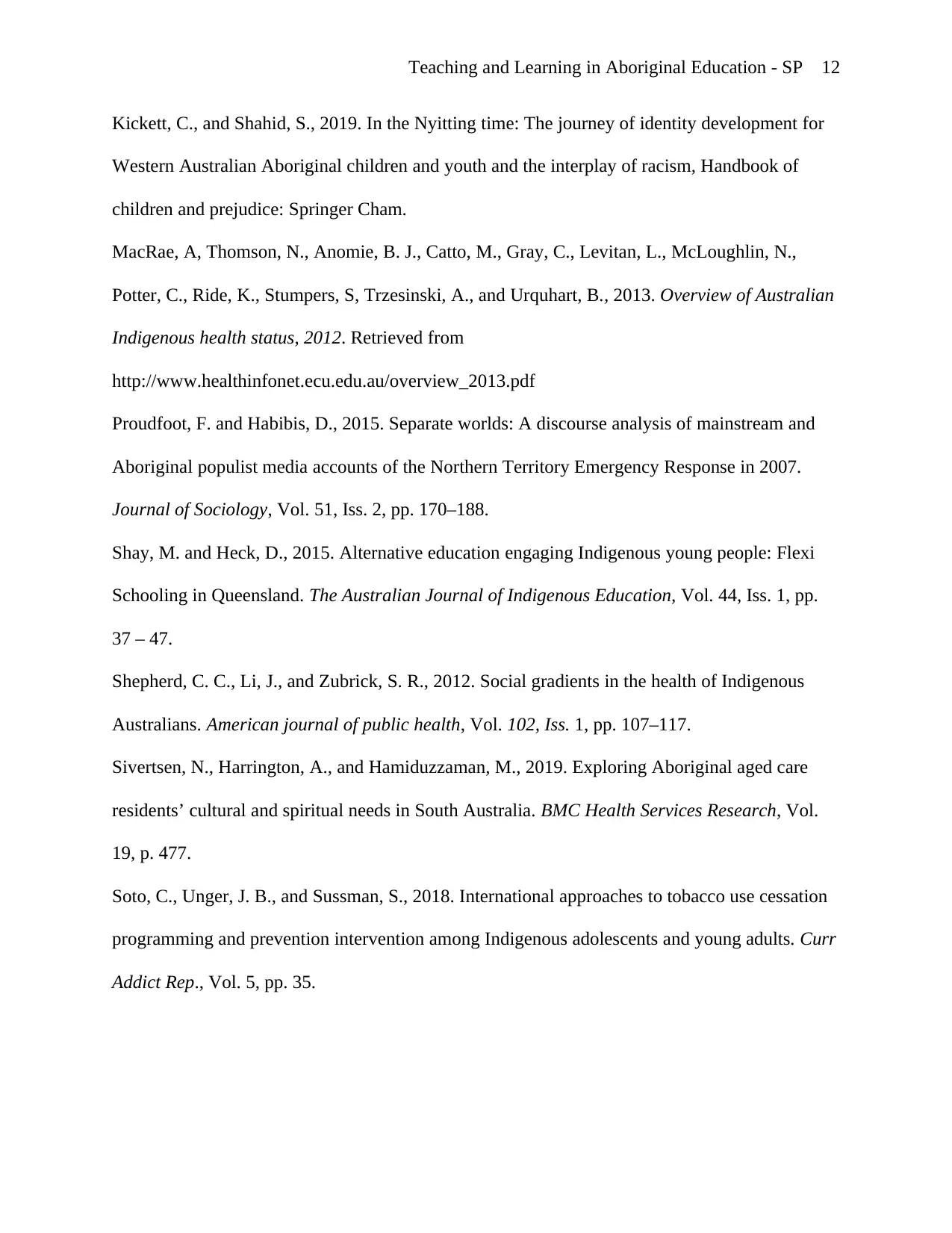
Teaching and Learning in Aboriginal Education - SP 12
Kickett, C., and Shahid, S., 2019. In the Nyitting time: The journey of identity development for
Western Australian Aboriginal children and youth and the interplay of racism, Handbook of
children and prejudice: Springer Cham.
MacRae, A, Thomson, N., Anomie, B. J., Catto, M., Gray, C., Levitan, L., McLoughlin, N.,
Potter, C., Ride, K., Stumpers, S, Trzesinski, A., and Urquhart, B., 2013. Overview of Australian
Indigenous health status, 2012. Retrieved from
http://www.healthinfonet.ecu.edu.au/overview_2013.pdf
Proudfoot, F. and Habibis, D., 2015. Separate worlds: A discourse analysis of mainstream and
Aboriginal populist media accounts of the Northern Territory Emergency Response in 2007.
Journal of Sociology, Vol. 51, Iss. 2, pp. 170–188.
Shay, M. and Heck, D., 2015. Alternative education engaging Indigenous young people: Flexi
Schooling in Queensland. The Australian Journal of Indigenous Education, Vol. 44, Iss. 1, pp.
37 – 47.
Shepherd, C. C., Li, J., and Zubrick, S. R., 2012. Social gradients in the health of Indigenous
Australians. American journal of public health, Vol. 102, Iss. 1, pp. 107–117.
Sivertsen, N., Harrington, A., and Hamiduzzaman, M., 2019. Exploring Aboriginal aged care
residents’ cultural and spiritual needs in South Australia. BMC Health Services Research, Vol.
19, p. 477.
Soto, C., Unger, J. B., and Sussman, S., 2018. International approaches to tobacco use cessation
programming and prevention intervention among Indigenous adolescents and young adults. Curr
Addict Rep., Vol. 5, pp. 35.
Kickett, C., and Shahid, S., 2019. In the Nyitting time: The journey of identity development for
Western Australian Aboriginal children and youth and the interplay of racism, Handbook of
children and prejudice: Springer Cham.
MacRae, A, Thomson, N., Anomie, B. J., Catto, M., Gray, C., Levitan, L., McLoughlin, N.,
Potter, C., Ride, K., Stumpers, S, Trzesinski, A., and Urquhart, B., 2013. Overview of Australian
Indigenous health status, 2012. Retrieved from
http://www.healthinfonet.ecu.edu.au/overview_2013.pdf
Proudfoot, F. and Habibis, D., 2015. Separate worlds: A discourse analysis of mainstream and
Aboriginal populist media accounts of the Northern Territory Emergency Response in 2007.
Journal of Sociology, Vol. 51, Iss. 2, pp. 170–188.
Shay, M. and Heck, D., 2015. Alternative education engaging Indigenous young people: Flexi
Schooling in Queensland. The Australian Journal of Indigenous Education, Vol. 44, Iss. 1, pp.
37 – 47.
Shepherd, C. C., Li, J., and Zubrick, S. R., 2012. Social gradients in the health of Indigenous
Australians. American journal of public health, Vol. 102, Iss. 1, pp. 107–117.
Sivertsen, N., Harrington, A., and Hamiduzzaman, M., 2019. Exploring Aboriginal aged care
residents’ cultural and spiritual needs in South Australia. BMC Health Services Research, Vol.
19, p. 477.
Soto, C., Unger, J. B., and Sussman, S., 2018. International approaches to tobacco use cessation
programming and prevention intervention among Indigenous adolescents and young adults. Curr
Addict Rep., Vol. 5, pp. 35.
⊘ This is a preview!⊘
Do you want full access?
Subscribe today to unlock all pages.

Trusted by 1+ million students worldwide
1 out of 13
Related Documents
Your All-in-One AI-Powered Toolkit for Academic Success.
+13062052269
info@desklib.com
Available 24*7 on WhatsApp / Email
![[object Object]](/_next/static/media/star-bottom.7253800d.svg)
Unlock your academic potential
Copyright © 2020–2025 A2Z Services. All Rights Reserved. Developed and managed by ZUCOL.





